

The Heroine’s Journey: How Campbell’s Model Doesn’t Fit – FANgirl Blog. In the first post of the Heroine’s Journey series, we defined the key concepts that form the basis of our heroine-centered storytelling model.

Not Everything Is A Hero’s Journey - Narrative First. There is a sickness running through the world, a sickness that attempts to twist every instance of narrative fiction through the siphon of errors that is the “Hero’s Journey” story structure paradigm.
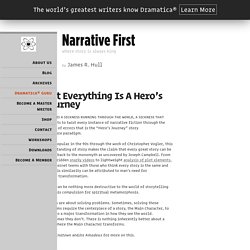
Made popular in the 90s through the work of Christopher Vogler, this understanding of story makes the claim that every great story can be traced back to the monomyth as uncovered by Joseph Campbell. From error-ridden snarky videos to lightweight analysis of plot elements, the Internet teems with those who think every story is the same and that this similarity can be attributed to man’s need for mythic transformation. There can be nothing more destructive to the world of storytelling than this compulsion for spiritual metamorphosis. Stories are about solving problems. Sometimes, solving those problems require the centerpiece of a story, the Main Character, to undergo a major transformation in how they see the world. See Chinatown and/or Amadeus for more on this. Forcing the Change. Writing Fiction: How to Structure a Killer Novel Ending.
There are more than a few writers and teachers out there, many of them orders of magnitude more famous than I am (not hard to do), who don’t like to compartmentalize or even attempt to define the sequential parts and essential milestones of a story’s plot structure.

Too formulaic, they say. Takes the fun and creativity out of it, they claim. A write-by-the-numbers strategy for hacks, a vocal few plead. Writing 10 Steps. Plot and Structure. The 15 Beats of Storytelling : Spaceballs3. The Five Beats of Successful Storytelling & How They Can Help You Land Your Next Job. Author Philip Pullman wrote, “After nourishment, shelter and companionship, stories are the thing we need most in the world.”
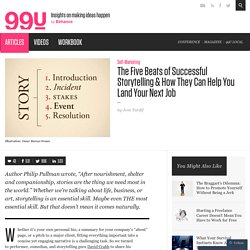
Whether we’re talking about life, business, or art, storytelling is an essential skill. Maybe even THE most essential skill. But that doesn’t mean it comes naturally. Whether it’s your own personal bio, a summary for your company’s “about” page, or a pitch to a major client, fitting everything important into a concise yet engaging narrative is a challenging task. So we turned to performer, comedian, and storytelling guru David Crabb to share his storytelling framework. 10 hints for index cards. How to Organize and Develop Ideas for Your Novel. What if you have so many ideas for your novel that the idea of an outline completely overwhelms you?

It’s good writing practice to keep a notebook or paper close by so that you can jot down ideas for your story as they arise—but when the result is a growing pile of mismatched odds and ends, how do you organize those ideas into some sort of coherent outline that will guide your writing? Or, conversely, what if you have a central idea for your story, but are unsure of where to go from there? Believe it or not, I’ve found the key to getting started from both of these situations can lie in the same simple method of creating scene cards. Say you’re in the first camp, the overwhelmed-by-random-ideas one.
To begin with the scene card method, you’ll start by taking out that notebook or file folder filled with little scraps of paper. Sounds simple enough, right? So, I began asking myself these questions and writing possible answers on scene cards. Why "Start With the Action" Messes Up So Many Writers. By Janice Hardy, @Janice_Hardy If I took a poll for the most common writing advice, “start with the action” would make the list.
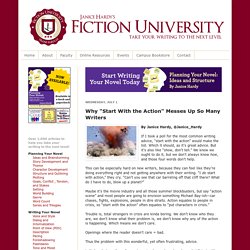
Diegesis. Diegesis /ˈdaɪəˈdʒiːsəs/ is a style of fiction storytelling that presents an interior view of a world in which: details about the world itself and the experiences of its characters are revealed explicitly through narrativethe story is told or recounted, as opposed to shown or enacted.[1] In diegesis the narrator tells the story.

The narrator presents the actions (and sometimes thoughts) of the characters to the readers or audience. In contrast to mimesis[edit] Diegesis (Greek διήγησις "narration") and mimesis (Greek μίμησις "imitation") have been contrasted since Plato's and Aristotle's times. Definition[edit] In filmmaking, the term is used to name the story depicted on screen—as opposed to the story in real life time that the screen narrative is about. In literature[edit] Diegesis is multi-levelled in narrative fiction. In film[edit] Thus, elements of a film can be "diegetic" or "non-diegetic". Film sound and music[edit] In musical theater[edit] In video games[edit] See also[edit] When to Discard the Three-Act Story Structure. There are times to follow the rules of story, and there are times to break the rules.
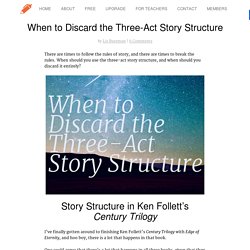
When should you use the three-act story structure, and when should you discard it entirely? Story Structure in Ken Follett’s Century Trilogy I’ve finally gotten around to finishing Ken Follett’s Century Trilogy with Edge of Eternity, and hoo boy, there is a lot that happens in that book. One could argue that there’s a lot that happens in all three books, given that they cover a one-hundred-year timespan, but the final installment felt much fuller than the other two. For some reason, it felt like the third book had more climactic peaks than the previous two, even though history has always been a series of events happening simultaneously in multiple locations. Famous Authors’ Handwritten Outlines for Great Works of Literature. Charts and Diagrams Drawn by Famous Authors. Being the literary nerds that we are over here, we’re obsessed with everything about our favorite authors, and particularly the little scraps of writerly intention — things that give us a view into an author’s thought process and planning technique, or even just a peek at the way they see and order the world.
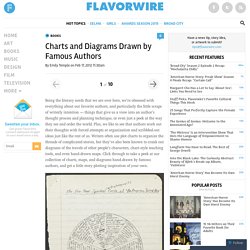
Plus, we like to see that authors work out their thoughts with forced attempts at organization and scribbled-out ideas just like the rest of us. Writers often use plot charts to organize the threads of complicated stories, but they’ve also been known to crank out diagrams of the travels of other people’s characters, chart-style teaching tools, and even hand-drawn maps. Click through to take a peek at our collection of charts, maps, and diagrams hand-drawn by famous authors, and get a little story-plotting inspiration of your own.
Jack Kerouac. How to Structure A Story: The Eight-Point Arc. By Ali Hale - 3 minute read One of my favourite “how to write” books is Nigel Watts’ Writing A Novel and Getting Published. My battered, torn and heavily-pencil-marked copy is a testament to how useful I’ve found it over the years. Although the cover appears to be on the verge of falling off altogether, I’ve risked opening the book once more to bring you Watts’ very useful “Eight-Point Story Arc” – a fool-proof, fail-safe and time-honoured way to structure a story. (Even if you’re a short story writer or flash fiction writer rather than a novelist, this structure still applies, so don’t be put off by the title of Watts’ book.) The eight points which Watts lists are, in order:
7 Steps for Writing a Novel in Scenes - Live Write Breathe. You’ll notice I didn’t include the word “easy” in the title of this post.
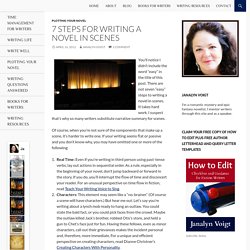
There are not seven “easy” steps to writing a novel in scenes. It takes hard work. I suspect that’s why so many writers substitute narrative summary for scenes. Of course, when you’re not sure of the components that make up a scene, it’s harder to write one. How to Write a Synopsis of Your Novel. By Glen C. Strathy* To sell your novel, you may need to know how to write a synopsis, even if you are a pantser-type novelist who can write a whole novel without making an outline first. Agents and publishers will often ask for a synopsis along with sample chapters before they request a complete manuscript. How to Plot a Novel With Index Cards. How a Scene List Can Change Your Novel-Writing Life. Writing Fiction: How to Structure a Killer Novel Ending.
Jimbutcher: The Great Swampy Middle. Every writer runs into this, generally in every single book. The middle. It lurks between the beginning of your book and the exciting conclusion, and its mission in life is to Atreyu you right down into the yucky, mucky mire in order to prevent you from ever actually finishing. The Great Swampy Middle (or GSM) knows no fear, no mercy, no regret. It doesn't come after you. One Sentence - True stories, told in one sentence. How to Make Readers Feel Emotion. On January 30th, 2011 by Fiction Editor Beth Hill and last modified on February 8, 2011 I wrote an article on the importance of creating emotions in readers, but I’ve noticed that writers are looking for specifics on how to accomplish that. So, this article complements that first one, presents practical tips on how to stir the reader’s emotions. Readers like to be touched, moved, by story.
7 Keys To Write the Perfect First Line of a Novel. 102 Resources for Fiction Writing « Here to Create. Exercises for Fiction Writers - Page 2. Stormwriting: What It Is and Why You Should Try It. Five Open Source Apps For Writers and Authors. By Lisa Hoover - Jul. 17, 2009Comments (9) Even if you have the perfect idea for the next Great American Novel, getting it down on paper is never easy. While you could always use standard word processors like OpenOffice Write or AbiWord, they don't have the bells and whistles that make writing books, manuals, and theses as easy as possible.
Fortunately, there are a few open source applications that help budding authors get stories out of their heads and into the hands of readers. Kabikaboo - This recursive writing assistant is perfect for managing large documents, technical manuals, and long novels. It arranges data in tree-form so parent modules, their children, and their grandchildren can be easily moved around and rearranged.
Why Children's Writers Should Write & Publish Short Stories. 1. Historical fiction and more. If your goal is to write and sell a novel, you need to know what agents and editors look for and what factors influence readers to purchase books . In this boot camp, literary agent Jim McCarthy will discuss the top 10 elements of a successful novel—that sells.
You’ll explore the effect e-publishing has on how novels are published, selected, and promoted. The Thirty-Six Dramatic Situations. A quick overview of the Hero’s Journey. 7 Reasons to Write an Entire 1st Draft before Going Back to the Beginning. 7 Essential Elements of Scene + Scene Structure Exercise. Scene-Creation Workshop — Writing Scenes that Move Your Story Forward. 7 Things How I Met Your Mother Can Teach Us About Writing. Structure. How To Write A Novel Using The Snowflake Method. The Universal Shapes of Stories, According to Kurt Vonnegut. A Simple Novel Outline – 9 questions for 25 chapters « H.E. Roulo. Framing The Story : TED Radio Hour. How to tell a great story, visualized.
Lesson Story Structure and Plot 3-12. How To Create An Intriguing Inciting Incident. Novel Writing: Choosing a Method that Works Best for You by Margo L. Dill. Monomyth. Three-act structure. The Story Spine.pdf. Kurt Vonnegut on the shapes of stories. Karpman drama triangle. Why 3 Act Will Kill Your Writing - Raindance. Freytag's Pyrmaid. Writing an Outline of Your Novel. Hero's journey.